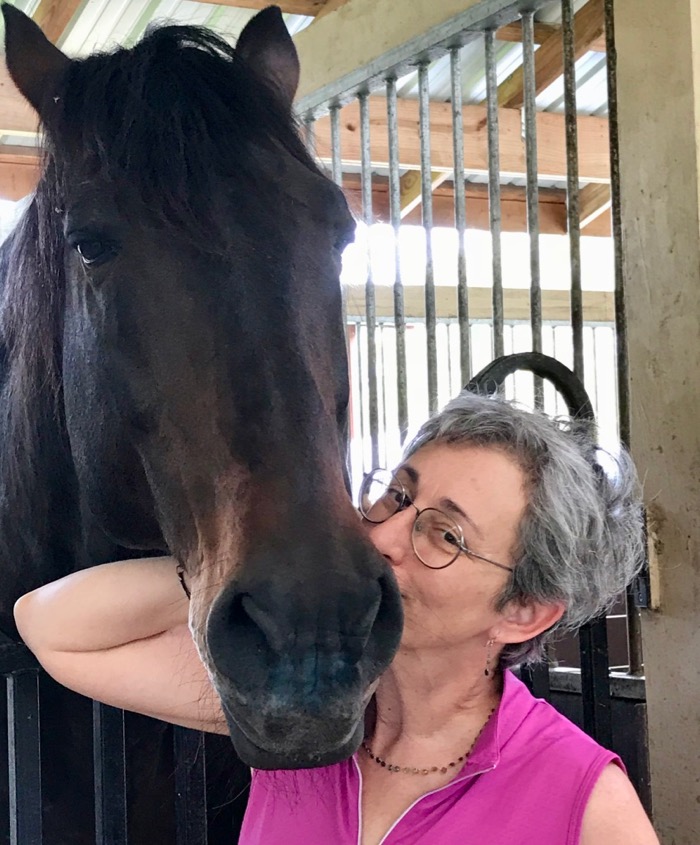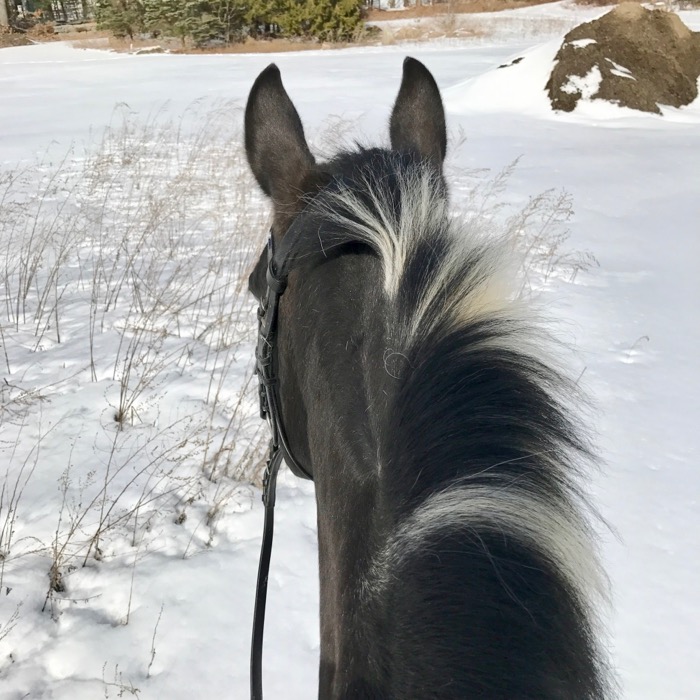One day last week I was feeling tired and stressed. If the weather had been good, I would have taken Tonka out on a trail. But the weather was not. I could have ridden in the arena. Being in the saddle would have distracted me and the exercise would have made me feel better. But I didn’t do that because it would have taken me awhile to get into a better mental place, and until I got there, Tonka would have had to absorb my bad mood and deal with a less than tactful rider.
Instead, I hand-walked him. I’ve been desensitizing Tonka to a whip and a lunge line, and walking around the arena, just trudging along, while holding those things, is what he needs to relax with them. It turned out it was also what I needed to shake off my mood.
It wasn’t a totally undemanding stroll. Tonka likes to mosey, and I did insist that he march along. As we reached the far wall, Tonka slowed. I could have tugged a little and kept him going, but this was different than his let’s take it easy pace. Tonka had noticed something. I could tell by the shift in his head carriage. I looked. The ring was freshly groomed. There was nothing. At least, there was nothing from my human perspective. But that doesn’t count for much. We humans can be quite dull to the world. Tonka nudged my arm with his nose. That’s his way of telling me to pay attention. If I don’t respond to that, when it’s important, Tonka has been known to grab my sleeve with his teeth. Gently, but determined. This is what happens when you allow a dialog between you and your horse. Horses communicate with body language, and Tonka figured this one out on his own. It works for us. However, he tried it with someone else, so I’m thinking about how to train him to get my attention in another way! Still, I’d rather that than not allow conversation, because if you don’t have a way for the horse to talk to you, that’s when they either “explode out of the blue” or shut down, or are constantly fearful, or any number of other behaviors that an animal does when their needs and concerns aren’t listened to.
I let Tonka stop. I gave him slack in the lead rope. Tonka’s nostrils flared. He didn’t look alarmed, but there was clearly something that he needed to investigate.

He pointed out this.

There was a wet spot on the wall. He put his nose right on it and sniffed. I have no idea what it was, but after a few big whiffs, Tonka said that it wasn’t important and that we could continue walking. If I hadn’t let him suss it out, he might have swerved around that spot for the rest of the walk. Or I’d have had to use pressure to keep him walking straight with me. As it was, Tonka didn’t hesitate at that spot again.
Tonka’s desire to stop and sniff does not stem from disobedience. Horses get more complete information from their sense of smell than sight (which is geared towards movement at distance. They can’t focus up close.) They sniff to determine if a horse is friend or foe.

They sniff humans to determine the same thing. (This is Tejo, a Spanish stallion. We’ve just met. Notice his wide nostrils taking in the scent of me, but his very relaxed ears and eyes – I’m scratching him in just the right place.)

I’ve written about this in other blogs. Once, at a show, Tonka saw a grey mare and thought it was his best friend Maggie, but only realized it wasn’t Maggie when he got a good whiff of her doppelgänger. (Read the full story here.)
He also used his sniffer to find a lost cell phone on a trail! (Read about that here.)
I don’t always let Tonka stop and smell. It’s certainly not okay when we’re riding a dressage test in front of a judge. However, it’s not all or nothing. With observation and training, your horse can tell you what they’re aware of, and then trust your decision if it’s not a good time to stop and sniff. It’s like taking a dog for a walk. There are times to walk politely and briskly, and other times to explore the world. (For a book about dogs and their sniffers, read this.) I always appreciate Tonka’s input. Why else sit on their back if you can’t see the world from their point of view?

note: for an in-depth article on horse vision read this piece in Equus Magazine. To learn more about equine olfactory ability read this.


My mare likes to sniff horse manure we come upon on the trail. If I’m on a mosey ride by myself or with just a close friend I usually let her sniff the first one and ask her if it’s anyone she knows. Anymore after that I tell her it’s not anyone she knows, and make her move on, and she is OK with that. One of my friends I ride with a lot and I have avoided bear by paying attention to how our horses are sniffing the air.
What do the horses do that’s different with bear scent vs. something else, like coyote?
Actually, they don’t pay much attention to coyote or deer, unless one jumps out in front of us. Our mares “bear” sniff involves an alert head and a lot of deep sniffing and huffing with the nostrils really wide, and of course they don’t want to go on. So we have usually backed off and waited and if they settle down and are willing to go, we go on, and have seen bear tracks so that is how I know what they are telling us. If they don’t settle down, we go a different way.
I really like the way you write about paying attention to Tonka’s actions.
My eventing mare April is usually pretty affectionate, but this morning when I was putting her studs in, she leaned her head down to where I was crowched and rested her muzzle on top of my warm, fuzzy hat. Shen then blew softly several times into the top of my head. That was the first time she took the time to do that. Usually she just rests her head on my shoulder and blows softly into my ear. It’s a wonderful feeling to get a kiss from a horse!
Those loving whuffles are gifts 🙂